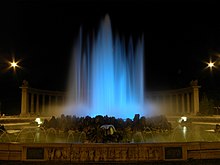High jet fountain

The Hochstrahlbrunnen is a fountain in Vienna . It is located on Schwarzenbergplatz and was put into operation on October 24, 1873 in the presence of Emperor Franz Joseph I on the occasion of the completion of the 1st Vienna High Spring Water Pipeline after a construction period of four months .
history
Anton Gabrielli , contractor of the water pipeline, donated 200,000 crowns for the construction of the fountain, which was built by contractor Gustav Bruck on behalf of the City of Vienna .
In 1886/87 extensive considerations were made about the regulation of Schwarzenbergplatz and, connected with this, about the new version of the high-jet fountain. The designs by the important sculptors Viktor Tilgner (1844–1896) and Rudolf Weyr (1847–1914) were presented to the public at the Vienna Künstlerhaus from the end of January 1887 , but no decision was made in their favor.
Later, the fountain, in the style of a Fontaine lumineuse by the architect Oskar Marmorek (1863-1909), was redesigned to a light fountain at a cost of 285,000 kroner, which was opened on June 23, 1906. At night it glows in the colors red, pink, yellow, purple, blue and green.
architecture
At the edge of the pool there are 365 small fountains that symbolize the days of the year. The six fountains between the edge of the pool and the inner island and these themselves correspond to the seven days of the week. Twelve high rays symbolize the months, 24 low rays the hours of the day and the 30 rays in the middle island the days of the month.
The original nozzle arrangement from 1873 consisted of a high jet for the year, four jets in the inner stone island for the seasons and 365 marginal jets for the days of the year.
In the green area towards Prinz-Eugen-Straße there is a monument by Franz Seifert to the geologist and palaeontologist Eduard Suess , who in 1836 as a member of the municipal council suggested the construction of a Viennese drinking water pipeline and campaigned for the regulation of the Danube . South of the Hochstrahlbrunnen is the monument to the heroes of the Red Army, erected in 1945 .
Technology, color choice, wintering
By opening an octagonal manhole cover in the floor next to the fountain, a spiral staircase leads to the cellar vault under the fountain. This is where the pumps, pipes and slides for operating the water jets and the power supply for the 6 color emitters are located. The splashing, crackling water can be seen and heard through sight glasses upwards. To einzuwintern the fountain, turn here 2 persons of the Vienna Waterworks, the lights and pump off and open the discharge gate . It takes about 3 hours to empty the basin and the pipes from 520 cubic meters of high spring water into the sewer system. The nozzles are replaced by blind plugs, the luminaire glasses are cleaned and covered. Operations run in the warmer half of the year from around the beginning of spring March 21 to around the end of October.
At night, the fountain usually glows in red, pink, yellow, purple, blue, and green. The terrorist attacks on November 13, 2015 in Paris prompted the lighting colors to be set to blue, white and red, the French national colors, by November 17. To mark the 50th anniversary of the national holiday , it was colored in the national colors on October 26, 2005 with 10 spotlights.
Since shortly before October 27, 2013, the lighting has been using light-emitting diodes , which consume less electrical energy than the previous technology.
Since 2015, the height of the fountains has been reduced in strong winds.
See also
Web links
- District Museum Landstraße - The high beam fountain ( Memento from January 1st, 2009 in the Internet Archive )
- 360 ° panorama picture of the high jet fountain
Individual evidence
- ^ K .: The opening of the high spring water pipeline. The new high-jet fountain. In: Local-Anzeiger der "Presse" , supplement to No. 294/1873 (XXVI. Year), October 25, 1873, p. 8, bottom left. (Online at ANNO ). .
- ↑ Little Chronicle. (...) The high-jet fountain. In: Neue Freie Presse , Morgenblatt, No. 3248/1873, September 7, 1873, p. 6, bottom left. (Online at ANNO ). .
- ^ The future scene of the Hochstrahlbrunnen in Vienna. In: The Interesting Sheet , No. 4/1887, January 27, 1887, p. 5, center right, f. (Online at ANNO ). .
- ↑ Little Chronicle. (...) The emperor in Prof. Tilgner's studio. In: Prager Tagblatt , supplement, No. 4/1873, January 4, 1887, p. 5, center right. (Online at ANNO ). .
- ↑ WL: Tilgner's and Weyr's plans. In: General Art Chronicle. Illustrated magazine for art, applied arts, music, theater and literature , No. 2/1887 (XI. Year), January 8, 1887, p. 34 f. (Online at ANNO ). .
- ↑ —n— .: Small Chronicle. (...) high-jet fountain projects. In: Neue Freie Presse , Morgenblatt, No. 8055/1887, January 30, 1887, p. 5, top left. (Online at ANNO ). .
- ↑ http://wien.orf.at/news/stories/2742898/ Christmas tree will shine blue-white-red, orf.at, November 18, 2015, accessed November 18, 2015.
- ↑ Hochstrahlbrunnen in red-white-red orf.at, October 26, 2005, accessed June 26, 2017.
- ↑ Vienna's most striking fountain is 140 years of orf.at, October 27, 2013, accessed June 26, 2017.
- ↑ Spring cleaning for 950 wells orf.at, March 21, 2015, accessed June 26, 2017.
Coordinates: 48 ° 11 ′ 54.2 " N , 16 ° 22 ′ 33.6" E


